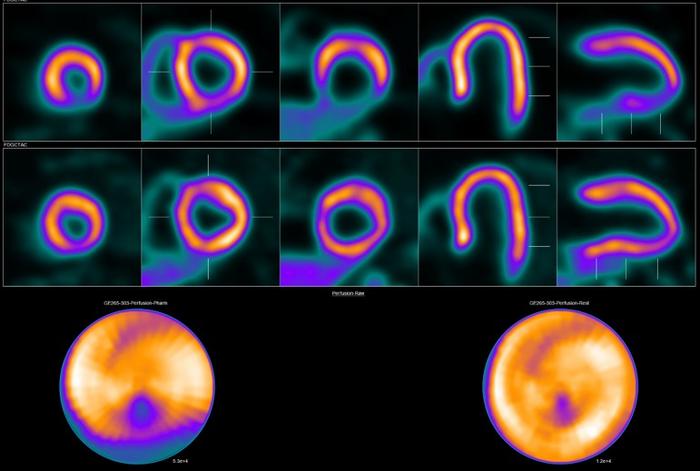Chicago, Illinois (Embargoed until 2:15 p.m. CDT, Tuesday, June 27, 2023)—A novel PET perfusion radiotracer, 18F-flurpiridaz, can diagnose coronary artery disease (CAD) in obese patients with a higher sensitivity and specificity compared to 99mTc-SPECT myocardial perfusion imaging (MPI), according to research presented at the 2023 Society of Nuclear Medicine and Molecular Imaging Annual Meeting. 18F-flurpiridaz PET MPI obtained images at a lower radiation dose than 99mTc-SPECT MPI and performed similarly in both obese and non-obese patients.
Obese individuals frequently have medical conditions such as diabetes, high cholesterol, and high blood pressure that put them at higher risk of developing CAD. Due to these risk factors, imaging obese patients for CAD is very important.
“Due to their body shape, it’s often hard to image obese individuals,” said Krishna Patel, MD, assistant professor of medicine and cardiology at the Icahn School of Medicine at Mount Sinai in New York. “This can result in inferior image quality and diagnostic performance despite requiring a higher dose of radiation.”
The study reports on a pre-specified subgroup of a phase III multicenter trial of 18F-flurpiridaz. A total of 604 patients with suspected CAD across 48 sites in the United States, Canada and Europe were enrolled in the study. Patients underwent one-day rest-stress 18F-flurpiridaz PET MPI or one- or two-day rest-stress 99mTc-SPECT MPI before undergoing invasive coronary angiography. MPI images were read by three experts blinded to clinical and invasive coronary angiography data. Sensitivity and specificity for 18F-flurpiridaz PET MPI and 99mTc-SPECT MPI were calculated and then compared between PET and SPECT MPI among obese and non-obese groups.
Of the 578 patients with evaluable studies, 298 (51.6 percent) were classified as obese. 18F-flurpiridaz PET MPI had a sensitivity of 77 percent and a specificity of 67 percent in diagnosing significant CAD, while 99mTc-SPECT MPI had a sensitivity of 69.2 percent and specificity of 61.9 percent. The sensitivity, specificity and accuracy of 18F-flurpiridaz PET MPI was similar in non-obese and obese sub-groups.
“Our research shows that 18F-flurpiridaz stress cardiac PET imaging is excellent for diagnosing significant coronary artery disease even in obese patients, and at a lower radiation dose than traditional 99mTc-SPECT MPI,” stated Patel.
Patel also noted that 18F-flurpiridaz could significantly increase availability of and access to PET myocardial perfusion imaging across the country, and potentially all over the world. “We know that PET perfusion is the best noninvasive imaging modality for CAD; however, thus far, the availability of stress cardiac PET myocardial perfusion imaging is limited across the world, as both significant investment for the generator and large patient volume are required for it to make economic sense,” she said. “With availability as a unit dose, 18F-flurpiridaz can disrupt this space, as suddenly now most—if not all—centers that offer PET for oncology can now perform stress perfusion studies.”
Abstract 1219. “Improved Assessment of Coronary Artery Disease in Obese Subjects with Flurpiridaz F-18 PET Myocardial Perfusion Imaging: A Subgroup Analysis of the Flurpiridaz F-18 303 Phase 3 Study.” Krishna Patel, Icahn School of Medicine At Mount Sinai, New York, New York; Jamshid Maddahi, UCLA School of Medicine, Los Angeles, California; Denis Agostini, University Hospital CHU Caen, Caen, France; Jeroen J. Bax, Universiteit Leiden, Leiden, Netherlands; Rob S.B. Beanlands, University of Ottawa Heart Institute, Ottawa, Ontario, Canada; Daniel Berman, Cedars-Sinai Medical Center, Los Angeles, California; Sharmila Dorbala, Brigham and Women’s Hospital, Boston, Massachusetts; Ernest V. Garcia, Emory University, Atlanta, Georgia; James Feldman, Memorial Hermann, Houston, Texas; Gary V. Heller, Morristown Medical Center, Morristown, New Jersey; Juhani M. Knuuti, Turku University, Turku, Finland; Pedro Martinez-Clark, Jackson North Medical Center, North Miami Beach, Florida; Matthieu Pelletier-Galarneau, Montreal Heart Institute, Montreal, Quebec, Canada; Benjamin Shepple, University of Tennessee Medical Center, Knoxville, Tennessee; Nagara Tamaki, Kyoto Prefectural University of Medicine, Kyoto, Japan; James E. Udelson, Tufts Medical Center, Boston, Massachusetts; and Timothy Bateman, Saint-Luke’s Health System, Mid America Heart Institute, Kansas City, Missouri.
Link to Session
###
All 2023 SNMMI Annual Meeting abstracts can be found online.

Credit: Images courtesy of Krishna Patel, Icahn School of Medicine At Mount Sinai, New York, New York.
Chicago, Illinois (Embargoed until 2:15 p.m. CDT, Tuesday, June 27, 2023)—A novel PET perfusion radiotracer, 18F-flurpiridaz, can diagnose coronary artery disease (CAD) in obese patients with a higher sensitivity and specificity compared to 99mTc-SPECT myocardial perfusion imaging (MPI), according to research presented at the 2023 Society of Nuclear Medicine and Molecular Imaging Annual Meeting. 18F-flurpiridaz PET MPI obtained images at a lower radiation dose than 99mTc-SPECT MPI and performed similarly in both obese and non-obese patients.
Obese individuals frequently have medical conditions such as diabetes, high cholesterol, and high blood pressure that put them at higher risk of developing CAD. Due to these risk factors, imaging obese patients for CAD is very important.
“Due to their body shape, it’s often hard to image obese individuals,” said Krishna Patel, MD, assistant professor of medicine and cardiology at the Icahn School of Medicine at Mount Sinai in New York. “This can result in inferior image quality and diagnostic performance despite requiring a higher dose of radiation.”
The study reports on a pre-specified subgroup of a phase III multicenter trial of 18F-flurpiridaz. A total of 604 patients with suspected CAD across 48 sites in the United States, Canada and Europe were enrolled in the study. Patients underwent one-day rest-stress 18F-flurpiridaz PET MPI or one- or two-day rest-stress 99mTc-SPECT MPI before undergoing invasive coronary angiography. MPI images were read by three experts blinded to clinical and invasive coronary angiography data. Sensitivity and specificity for 18F-flurpiridaz PET MPI and 99mTc-SPECT MPI were calculated and then compared between PET and SPECT MPI among obese and non-obese groups.
Of the 578 patients with evaluable studies, 298 (51.6 percent) were classified as obese. 18F-flurpiridaz PET MPI had a sensitivity of 77 percent and a specificity of 67 percent in diagnosing significant CAD, while 99mTc-SPECT MPI had a sensitivity of 69.2 percent and specificity of 61.9 percent. The sensitivity, specificity and accuracy of 18F-flurpiridaz PET MPI was similar in non-obese and obese sub-groups.
“Our research shows that 18F-flurpiridaz stress cardiac PET imaging is excellent for diagnosing significant coronary artery disease even in obese patients, and at a lower radiation dose than traditional 99mTc-SPECT MPI,” stated Patel.
Patel also noted that 18F-flurpiridaz could significantly increase availability of and access to PET myocardial perfusion imaging across the country, and potentially all over the world. “We know that PET perfusion is the best noninvasive imaging modality for CAD; however, thus far, the availability of stress cardiac PET myocardial perfusion imaging is limited across the world, as both significant investment for the generator and large patient volume are required for it to make economic sense,” she said. “With availability as a unit dose, 18F-flurpiridaz can disrupt this space, as suddenly now most—if not all—centers that offer PET for oncology can now perform stress perfusion studies.”
Abstract 1219. “Improved Assessment of Coronary Artery Disease in Obese Subjects with Flurpiridaz F-18 PET Myocardial Perfusion Imaging: A Subgroup Analysis of the Flurpiridaz F-18 303 Phase 3 Study.” Krishna Patel, Icahn School of Medicine At Mount Sinai, New York, New York; Jamshid Maddahi, UCLA School of Medicine, Los Angeles, California; Denis Agostini, University Hospital CHU Caen, Caen, France; Jeroen J. Bax, Universiteit Leiden, Leiden, Netherlands; Rob S.B. Beanlands, University of Ottawa Heart Institute, Ottawa, Ontario, Canada; Daniel Berman, Cedars-Sinai Medical Center, Los Angeles, California; Sharmila Dorbala, Brigham and Women’s Hospital, Boston, Massachusetts; Ernest V. Garcia, Emory University, Atlanta, Georgia; James Feldman, Memorial Hermann, Houston, Texas; Gary V. Heller, Morristown Medical Center, Morristown, New Jersey; Juhani M. Knuuti, Turku University, Turku, Finland; Pedro Martinez-Clark, Jackson North Medical Center, North Miami Beach, Florida; Matthieu Pelletier-Galarneau, Montreal Heart Institute, Montreal, Quebec, Canada; Benjamin Shepple, University of Tennessee Medical Center, Knoxville, Tennessee; Nagara Tamaki, Kyoto Prefectural University of Medicine, Kyoto, Japan; James E. Udelson, Tufts Medical Center, Boston, Massachusetts; and Timothy Bateman, Saint-Luke’s Health System, Mid America Heart Institute, Kansas City, Missouri.
Link to Session
###
All 2023 SNMMI Annual Meeting abstracts can be found online.
About the Society of Nuclear Medicine and Molecular Imaging
The Society of Nuclear Medicine and Molecular Imaging (SNMMI) is an international scientific and medical organization dedicated to advancing nuclear medicine and molecular imaging—vital elements of precision medicine that allow diagnosis and treatment to be tailored to individual patients in order to achieve the best possible outcomes.
SNMMI’s members set the standard for molecular imaging and nuclear medicine practice by creating guidelines, sharing information through journals and meetings and leading advocacy on key issues that affect molecular imaging and therapy research and practice. For more information, visit www.snmmi.org.
Journal
Journal of Nuclear Medicine
Article Title
Improved Assessment of Coronary Artery Disease in Obese Subjects with Flurpiridaz F-18 PET Myocardial Perfusion Imaging: A Subgroup Analysis of the Flurpiridaz F-18 303 Phase 3 Study




